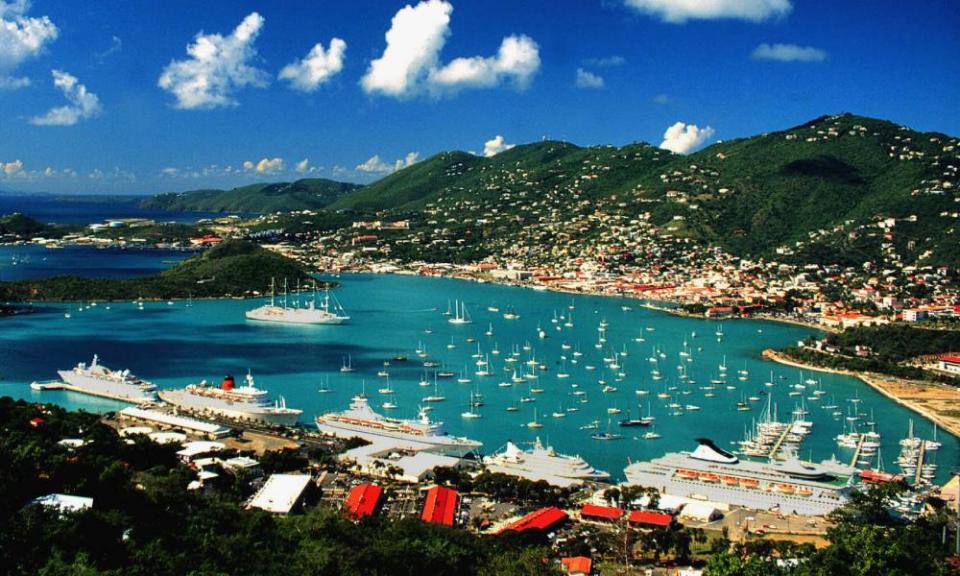Charlotte Amalie in the spotlight: beloved of cruise ships, neglected by US

The Caribbean’s busiest cruise-ship destination, the city of Charlotte Amalie is celebrating a sea-change centenary. One hundred years ago on Friday, the US paid $25m in gold coins to Denmark, buying what became the US Virgin Islands archipelago. One of these islands was St Thomas, the 13-mile-long island that seats the 18,000-strong capital, whose deep-water harbour has made Charlotte Amalie the first port of call for turquoise waters, artisanal jewellery and copious rum cocktails.

Left behind
As for how locals view the anniversary? It’s complicated. Many US Virgin Islanders feel abandoned by mainland America, according to Chelcie Porter, 35, a photographer and owner of a travel company in the city. “We don’t really feel supported by the United States,” she says. “Any attention that we do get is more likely to be a threat to send in troops to stop gun violence – never anything to bring in youth programmes, or create more employment, or drive down the very expensive cost of living.”
With some pretty Danish colonial architecture, Caribbean cuisine, an extinct Dutch creole and a living English-based one, the locals have their own identity. “People here don’t consider themselves American,” says Porter. “It’s the Caribbean, and the Caribbean’s not on anyone’s radar as important. It’s a very forgotten-about place, outside of a few rum cocktails.”
City in numbers …
8 Number of children borne by Queen Charlotte Amalie of Hesse-Kassel, the 17th-century monarch after whom the city is named
103 Africans aboard the first slaving vessel to arrive in St Thomas in 1673
1.5m Cruise-ship tourists welcomed annually
8.7m Daily gallons of freshwater supplied by the US Virgin Islands’ six desalinisation plants. All new houses are required to have a rainwater cistern
300 Minimum number of artisanal jewellery shops
… and pictures
Artist Dara Monifah’s Instagram page turns away from the shoreline hedonism of most tourist feeds and teases out the tastes, sounds and skills of Charlotte Amalie culture and activism.
A post shared by DaraMonifah Cooper (@daramonifah) on Aug 29, 2015 at 2:43pm PDT
History in 100 words
Columbus skipped through the islands in 1493, but the real history of Charlotte Amalie begins in 1671. It was then that the Danish West India Company was authorised to set up sugar plantations on St Thomas. Amid the slavery-driven boom that ensued, the city of Taphus – named after the beer halls spilling out onto the quayside – was born. Pirates like Blackbeard (supposedly) and William Kidd (definitely) stopped by for a tankard, much as present-day tourists still pop in for a Danish Navy Sour. Meanwhile, the slave-runners – who supplied the labour for the plantations – created the ethnic ratio still in place today: 76% Afro-Caribbean, 15.6% white. Yet racial tension is remarkably low. “I don’t feel it’s racially charged all the time, like in the States, and that’s priceless for me,” says Porter, who grew up in Chicago. “In St Thomas, I have police officers who are my friends. I hug them when I see them.”
Charlotte Amalie in sound and vision
They hit the beach after dark, naturally, but Edward and Bella’s vampire honeymoon in The Twilight Saga: Breaking Dawn – Part 1 was at Magens Bay, just over the hill from the city
After being shot in the leg in Charlotte Amalie in 2012, influential reggae artist Pressure Busspipe organised a peace concert in response to rising levels of gun violence in the city.
What’s everyone talking about?
Apart from being the only part of the US to drive on the left-hand side, the other thing you’ll notice about Charlotte Amalie’s roads is their ubiquitous potholes. One local suspension-wrecker was so big, according to travel writer Karen Elowitt, it was nicknamed “the Swimming Pool”. Highway maintenance suffers from a weak tax base and lack of federal government support. With the federal government taking its eye off the ball in Charlotte Amalie, local politics – which, says Porter, is beset by “nepotism and embezzlement” – takes on an intensified importance for residents.
What’s next for the city?
Fort Christian, the city’s oldest colonial building, reopens this week after a decade of renovation. It’s another box to tick off on the cruise-ship itinerary – but there’s also a boom in more self-sufficient enterprise that is less beholden to the tourism conveyor belt. Technologically savvy millennials are beginning to create their own opportunities, building a thriving downtown arts scene around the new Arc Vodka Distillery; the hope is sustained employment for locals. “I think Thomians are definitely starting to recognise their power,” says Porter. “At the same time, it’s an us-against-them thing. A lot of people felt they couldn’t get ahead and they had to make their own way.”
A post shared by ARC Vodka LLC (@arc_vodka) on Dec 11, 2015 at 6:34am PST
Close zoom
The Virgin Islands Daily News – one of the smallest newspapers ever to win the Pulitzer prize (for a 1995 investigation into local corruption) – is the paper of record. VINow is a wide-ranging local guide taking in history, cultural events and activity ideas.

 Yahoo News
Yahoo News 
